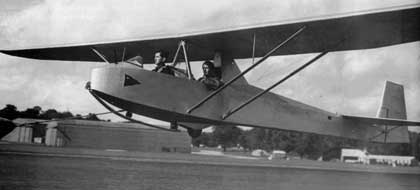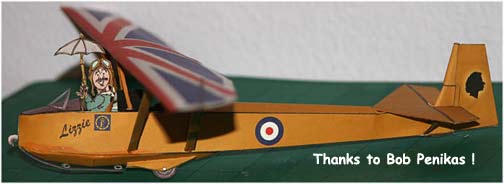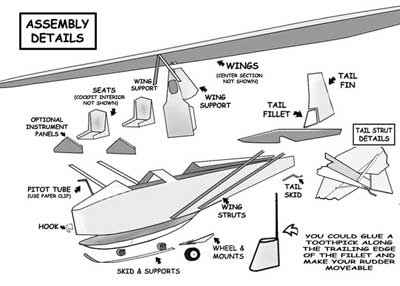
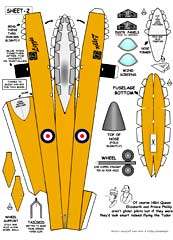
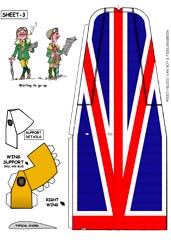
Slingsby-Tutor - $$7.50
The T.31 was a tandem two-seat development of the T.8 Tutor. A single T.31A prototype was flown in 1949, followed by the production T.31B, with spoilers and a small additional wing bracing strut. T.31s were exported to Burma, Ceylon, Israel, Jordan, Lebanon, Pakistan and Rhodesia.
Slingsby T-31, Tandem Tutor (Cadet Mark 3)

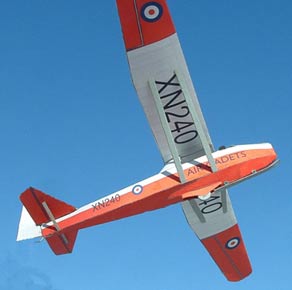
In Britain a large wartime industry had been set up manufacturing military transport gliders. In addition the Air Training Corps (ATC) used hundreds of 'Cadet' and 'Tutor' trainers. The chief manufacturer, Slingsby, was ready immediately to produce again for the civilian market.
Other firms had appeared, notably Martin Hearn in association with Slingsby, and Elliott's of Newbury, a former furniture manufacturer turned aircraft builder. Horace Buckingham, the proprietor, hoped to find new markets in the revived civilian flying clubs. But the expected growth was much smaller than anticipated. There was no subsidy and little or no official interest. The clubs could hardly cope with the numbers that did appear for they were desperately short of aircraft and equipment. The London Gliding Club based at Dunstable was forced to turn newcomers away at first.
There were powered versions of this aircraft.
I built 2 models of it, one
at 27", and another at 39" span, for various model
aircraft engines/motors.
Ed Toner
Slingsby Gliders

The Air Training Corp more commonly known as the ATC or Air Cadets, is a youth organization for 13 to 18 year olds, which is supported and funded by the Royal Air Force (RAF). The aims of the ATC are the same today as they were in 1941 when they were first formed:
"To promote and encourage among young men and women a practical
interest in aviation and the Royal Air Force; it seeks to provide
training that will be useful in the services and civilian life.
It fosters the spirit of adventure and to develop the qualities
of good leadership and citizenship".

Slingsby Type-21 Glider (not modeled):
The prototype made its first flight in September 1950
and was followed by some 200 production machines. Most were delivered
to the RAF Air Training Corps on behalf of the Air Cadets, providing
eager young men a reliable mount to conquer the skies.
The Type 21 prototype, with a span of 50 ft was rejected by the ATC at first and was saved only when bought by the London Gliding Club. It was soon found it to be extremely useful and the club ordered another, with suggested improvements. Slingsby lengthened the wings and improved the fuselage. The new two-seater was demonstrated at the British National Competitions in 1947 and attracted orders. The T - 21B entered production. It became the standard training sailplane for British civilian gliding clubs and remained so until well into the 1960s. The ATC had second thoughts and also ordered the type, giving it the name 'Sedbergh'.
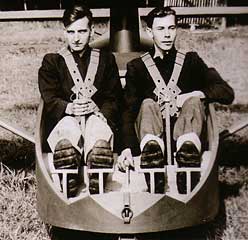 The
T -21 was in most respects an enlarged Grunau Baby. The two seats
were side by side in the open cockpit. Instructors generally preferred
this arrangement because it enabled them to converse normally
with the student and observe facial expressions. That there was
some inescapable drag penalty hardly mattered in a trainer. The
small windscreens were very effective in deflecting the airflow
away from the pilots' faces. If the airspeed was not well controlled
this became obvious immediately in the cockpit.
The
T -21 was in most respects an enlarged Grunau Baby. The two seats
were side by side in the open cockpit. Instructors generally preferred
this arrangement because it enabled them to converse normally
with the student and observe facial expressions. That there was
some inescapable drag penalty hardly mattered in a trainer. The
small windscreens were very effective in deflecting the airflow
away from the pilots' faces. If the airspeed was not well controlled
this became obvious immediately in the cockpit.
The fuselage aft of the wing was a triangulated timber frame covered
in fabric except underneath where plywood skin was used to protect
against damage on rough ground. The wing, like the Grunau Baby,
had a single main spar, with a single strut. The leading edge
was the usual kind of plywood skinned 'D-sectioned' torsion tube
with fabric covering behind. Spoilers were fitted on the upper
side. These, though not very effective, were powerful enough for
a pupil to sense the difference when they were opened or closed.
For reasons of balance the seats had to be set back under the leading edge of the wing. The view from the cockpit upwards and into a banked turn was limited, which was the only important disadvantage of the sailplane. Since the wing was mounted high on a narrow pylon, it was easy to look sideways and aft under the wing, so despite the wing overhead, in practice the all round vision was acceptable.
Slingsby T.31 Tandem Tutor I (The featured model)
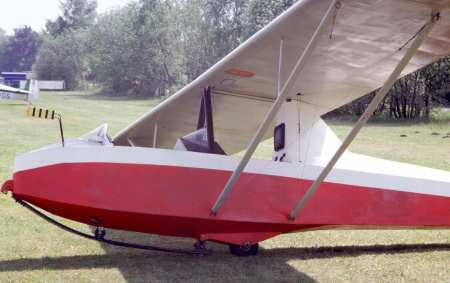 When
Slingsby introduced the Type 31 it was called the Tandem Tutor
and it was perfect for training flights by pupils who had progressed
to the Kirby Kadet and were ready to move on. The Tutor, or Cadet
Mark 2, was built in quantity for the ATC and more were produced
after 1946 for civilian use. In 1949 although the T - 21 was already
becoming accepted as an excellent trainer, some clubs, particularly
where the landing field was relatively rough, required a robust
two seater with better performance and handling like the Tutor.
When
Slingsby introduced the Type 31 it was called the Tandem Tutor
and it was perfect for training flights by pupils who had progressed
to the Kirby Kadet and were ready to move on. The Tutor, or Cadet
Mark 2, was built in quantity for the ATC and more were produced
after 1946 for civilian use. In 1949 although the T - 21 was already
becoming accepted as an excellent trainer, some clubs, particularly
where the landing field was relatively rough, required a robust
two seater with better performance and handling like the Tutor.
Some Tandem Tutors were modified into motor gliders, substituting the front seat for a VW or similar power plant. For ease of ground handling, The T.31 gained a narrow undercarriage replacing the single wheel. It had strengthened wings and some additional bracing of the struts. To develop a two seat glider from this involved very little work, requiring only that a front cockpit should be spliced onto the fuselage instead of engine bearers. To fit the engine in the nose the fuselage had been widened. This made room for the rear pilot's feet and rudder pedals to be placed on either side of the front seat.
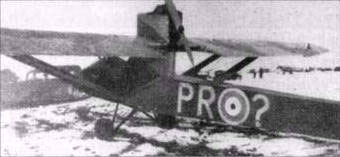 BAC
DRONE DE LUXE - One example of this powered glider, G-AEKT,
with a Garden Ford engine, was flown (in full RAF colors
and coded PR-?) for light relief by pilots of No 609 Sqn
until April 1941, when it was destroyed. One other Drone
(G-AEKM) was used briefly in 1941/42 by various establishments
at Ringway. BAC
DRONE DE LUXE - One example of this powered glider, G-AEKT,
with a Garden Ford engine, was flown (in full RAF colors
and coded PR-?) for light relief by pilots of No 609 Sqn
until April 1941, when it was destroyed. One other Drone
(G-AEKM) was used briefly in 1941/42 by various establishments
at Ringway.
Max speed, 73 mph (117
km/h). Gross weight, 720 lb (327 kg) . Span, 39ft 8 in
(12. 09 m). Length, 21ft 2 in (6. 45 m).
|
The Tandem Tutor was tested by the BGA and came on the market from 1951. There were exports to many countries of complete aircraft and kits of parts. The Air training Corps took 131 and named them the Cadet Mark 3.
The T-31 Tutor has a completely wooden structure, the fuselage, tailplane and the rear part of the wing being fabric covered. As a training glider, the T.31 is flown either from the front seat by the student or from the rear seat by the instructor- full controls and instrumentation being provided for both occupants. More than 200 T-31s were built. Some are still flying as vintage gliders.
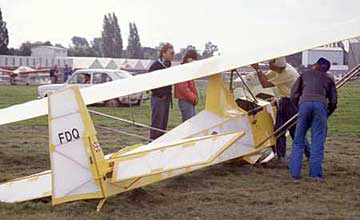 |
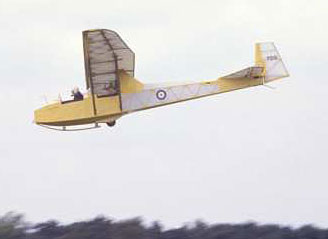 |
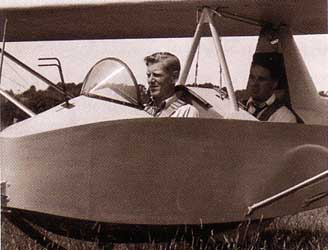  |
|
|
|
  Two good photos of the Slingsby tandem configuration cockpit |
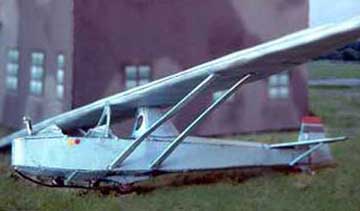 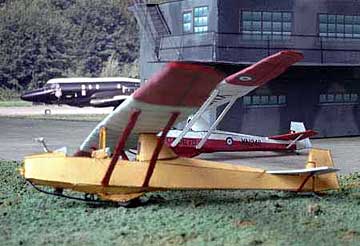 These are a couple of the models Guido made while working out the Slingsby Tutor model. Note the WWII control tower he added for effects |
  The Slingsby Tutor nose and skid details |
` 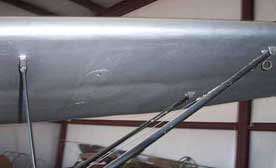  The Slingsby Tutor wing struts and tailplane |
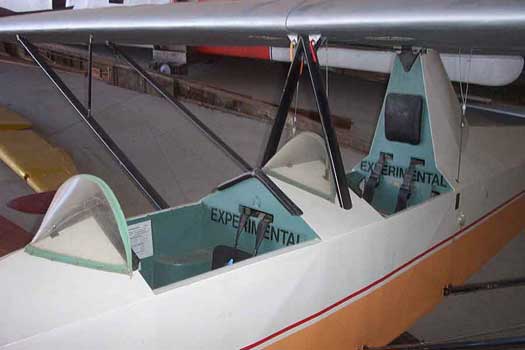 |
 |
Specifications for the Slingsby T-31 Tandem Tutor
 |
Length: 23 ft 3.5 in |
 Here's Guido Van Roy, Belgium, the designer of this Slingsby Tutor model. |
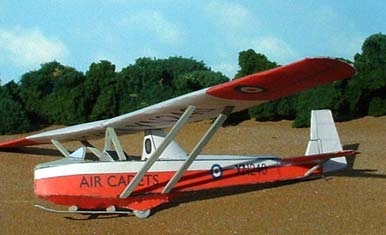 Thanks to Modeln' Pal, Dick Doll, who usually email using photos of great made-up models as they're released. |



